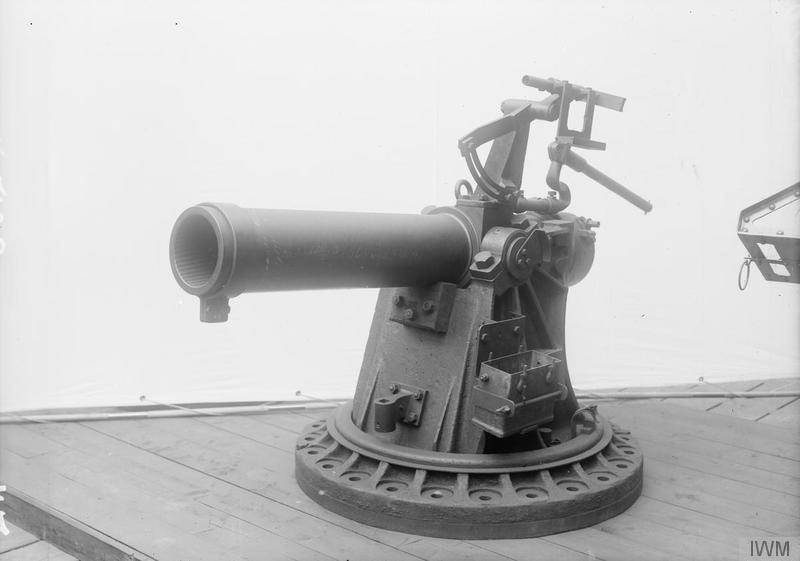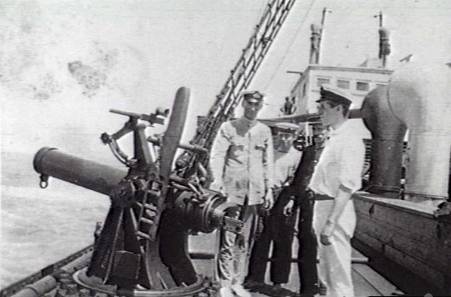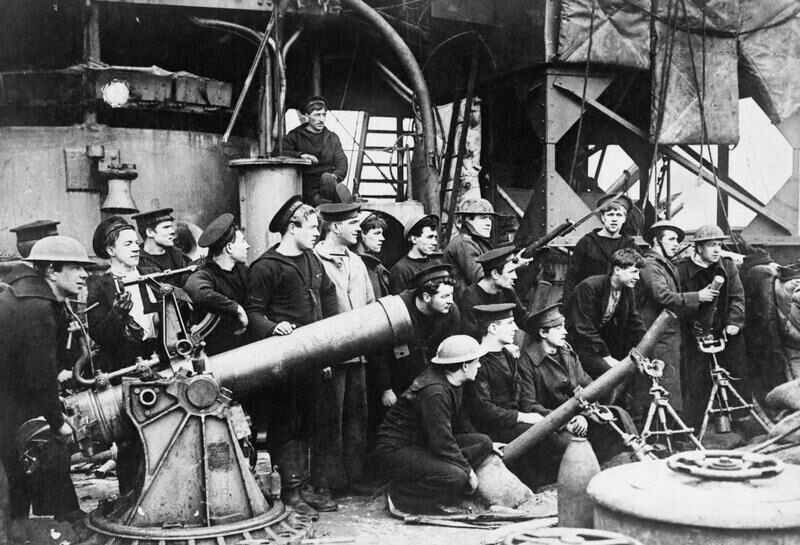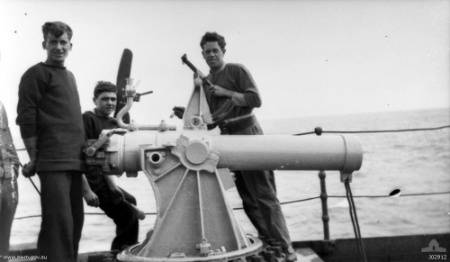Anti-submarine howitzer BL 7.5-inch naval howitzer (UK)
The main problem of depth charges was the specific requirements for the carrier. The ship or boat, armed with them, should have been distinguished by high speed and maneuverability. Thus, large warships or transports, in need of protection, could not use powerful and effective weapons. This problem could be solved by organizing a cover, but this led to known difficulties. The way out could be some kind of weapon capable of solving combat missions regardless of the characteristics of the carrier ship.

General view of BL 7.5-inch naval howitzer product
No later than the end of 1916, a proposal appeared that, as it seemed, could help the military and merchant fleet. Specialists of the maritime department offered to equip ships and vessels with special weapons optimized for the needs of anti-submarine defense. Soon the first project of such a system was developed, which received the symbol BL 5-inch naval howitzer (“Breech-loading 5-inch sea howitzer”).
The basis of the new project was the idea of defeating a submarine with a blast wave from a high-power high-explosive projectile. The high power of the projectile was required to be supplemented by a sufficient range of fire. Finally, a new stand was needed. Part of the tasks could be solved using the components of land howitzers of the appropriate caliber. By the beginning of 1917, one of the UK’s enterprises had received an order to convert a dozen land howitzers into anti-submarine weapons.
At the very beginning of the 1917 12 systems, the BL 5-inch naval howitzer passed the necessary tests. Working at the site, these products, in general, confirmed the viability of the original idea. However, there were serious flaws. 127-mm howitzer projectile high-explosive action carried insufficient explosive charge. As a result, the real power when shooting at a submarine was insufficient. The impossibility of obtaining the desired combat characteristics led to the abandonment of the 5-inch howitzer and the start of the development of a new system of increased caliber.
The basis for the new system took one of the serial guns caliber 7,5 inch (190 mm). As a result, a promising anti-submarine howitzer was called the BL 7.5-inch naval howitzer. Also, from a certain time, it began to be designated as Mark I, which indicated a possible development of the project in the future.
The first project involved the use of a shortened barrel of a production model. The fact is that the existing British 190-mm guns differed by a rather large firing range, which simply exceeded the visual detection distance of the submarine. As a result, for installation on a new carriage, the existing rifled barrel should be shortened to 1,62 m, taking into account the chamber (in total, 8,5 caliber). This allowed an acceptable way to reduce the initial velocity of the projectile and reduce the firing range to a practically applicable level.
The short rifled barrel was equipped with a reduced chamber for a reduced propellant charge and was equipped with a piston lock, locked with a turn around its axis. At the breech of such a howitzer provided mounting for the installation of sights. A characteristic feature of the project BL 7.5-inch naval howitzer was the lack of recoil devices. The whole recoil impulse was to be transmitted to the stand installation, and then to the deck and the power set of the carrier.
Especially for anti-submarine howitzers was developed the original tumbovaya installation. According to some data, the main aspects of its appearance were identified in the first project, and when creating an 7,5-inch system, the existing structure was refined to reflect new loads.

Anti-submarine howitzer aboard SS Boohan
It was proposed to mount a large and powerful installation of a complex shape on a suitable part of the deck of the carrier ship. Its lower unit was a circular support platform consisting of a pair of flat parts. Along the perimeter of the platform were many holes for mounting screws. The absence of recoil devices has led to the need to use the strongest support possible. The center of the platform had a kind of shoulder strap. Inside it there was a rail for moving the gun mount. The displacement of the latter was prevented by a pressure ring.
On the platform, movably, with the possibility of rotation around the vertical axis, a U-shaped stand was installed in plan. In its upper part there were supports for the axles of the gun cradle. The barrel was mounted on the installation using a small rectangular cradle with pins on the sides. Nearby was a helical mechanism of vertical guidance.
On the upper part of the cradle was placed vertical support, used in the sighting devices. The suggestion was proposed to carry out using a system consisting of a set of levers, rods and sectors, which were placed on a mechanical sight. When the position of the barrel was changed, the sight moved in the vertical plane in the required manner, indicating the landing point of the projectile.
190-mm anti-submarine howitzer was supposed to use special projectiles. The ammunition was first developed based on the construction of a standard high-explosive grenade for 7,5-inch howitzers. It had a metal body with an ogival head, weighed 100 pounds (45,4 kg) and carried a charge in the form of 43 pounds (19,5 kg) of TNT. A contact detonator with a two-second delay was applied, triggered after hitting the water or penetrating the hull of a submarine target. To launch the projectile, a powder charge of relatively low mass was used.
Later, a heavier and more powerful anti-submarine ammunition was created. It had a different body shape and had a mass of 500 pounds (227 kg). Half the mass of such a projectile was an explosive. A separate propellant charge was not developed for this shot.
Depending on the angle of elevation, the BL 7.5-inch naval howitzer howitzer could attack targets at different ranges. When using an earlier "light" projectile, the initial speed was only 146 m / s, and the maximum firing range reached 2100 yards (1920 m). 500-pound ammunition could be sent at a distance of no more than 300 yards (275 m). A direct hit by both projectiles could cause fatal damage to the submarine. Medium or minor damage was possible with a slip of up to several tens of meters, but the removal of the submarine from the system was no longer guaranteed.

The crew of the cruiser HMS Vindictive and 7,5-inch howitzer. Picture taken after the ship returned from a raid on Zeebrugge in April 1918.
Development of the project BL 7.5-inch naval howitzer with subsequent assembly and testing of prototypes continued until the end of the spring 1917 of the year. Having received positive reviews, the instrument was recommended for mass production. Already in June of the same year, the industry transferred the first batch of howitzers to the fleet. In total, it was planned to manufacture several batches of such weapons - a total of at least one thousand units.
According to reports, serial production of 190-mm howitzers lasted at least until the middle of the 1918 year. By December, the 1917-th customer received a little less than 400 systems. The rest were delivered later. For all the time of production, the UK manufactured 950 guns in the original configuration. After that, an updated howitzer was put into the series. Unlike the base product, the new gun had a smooth barrel. In addition, there were some other minor improvements.
Already after the release of the guns, improved projectiles were developed. The only difference between such ammunition was the presence of a special ring on the head. This made it possible to shoot with small elevation angles, not being afraid of ricochets from the water and confidently hitting underwater targets.
Record production rates made it possible to equip the BL 7.5-inch naval howitzer with a significant number of ships and vessels of the military and merchant fleet. The main carriers of such weapons were light and medium patrol boats and ships. In addition, a significant part of howitzers intended for transports, which were the main purpose of enemy submarines. A noticeable number of anti-submarine howitzers was installed on large ships of various types. For example, the cruiser HMS Vindictive received a pair of such systems.
It should be noted that not all the positive features of the new weapon were successfully implemented in practice. The absence of recoil devices made special demands on the strength of the deck and imposed restrictions on howitzers. In addition, the circular guidance was always impossible due to the presence of superstructures, gun turrets, etc. Nevertheless, even with such restrictions ships and ships got a certain chance to fight with submarines.
German submarines were a great danger to the British fleet, and therefore anti-submarine systems were of particular importance. However, for various reasons, very little is known about how to use BL 7.5-inch naval howitzer. Moreover, almost all the remaining information describes the use of these weapons for other purposes. However, these cases are of particular interest.
28 March 1918, the 190-mm howitzer was used in combat with a submarine, but the submarine was not its target. It all started with the fact that the crew of one of the transport ships noticed the approaching torpedo. The ammunition was at a distance of 600 yards (less than 550 m) and was heading for the ship. Having made the right leadthrough, the gunners were able to lay the 7,5-inch projectile near the torpedo. From the blast, she changed course and rose to the surface of the water at a distance of about 60 yards from the ship. The second well-aimed shot and the explosion following it immobilized the torpedo. The escort ship soon found and examined the torpedo: it was seriously damaged and lost its charging compartment.

Australian transport howitzer SS Orca, 6 March 1919
23 April 1918, the Royal Navy's ship group conducted a so-called Raid on Zeebrugge. The fleet of ships and boats 75 was attended by several carriers of 190-mm howitzers, including the cruiser HMS Vindictive. The risk of submarine attacks was minimal, so anti-submarine weapons were decided to be used as conventional artillery. The BL 7.5-inch naval howitzer calculations were supposed to attack specified coastal targets, enemy ships and ships, etc. In this case, the main task of the guns of the cruiser HMS Vindictive was to support the actions of the marines, landed on the coast.
Information on other cases of combat use of BL 7.5-inch naval howitzer howitzers is missing. It can be assumed that such a weapon should have shown an acceptable probability of hitting targets. The advantages of such a system include the possibility of free-range with different angles (with known limitations), as well as a relatively high rate of fire. The relatively low mass of the explosive charge, the low initial velocity and the long duration of the projectile, in turn, were disadvantages.
However, it is not difficult to determine that a “light” projectile, when fired at a maximum range, could remain in the air for up to 20-25 seconds. When firing at a moving target, such a flight time could be critical, but far from all cases the enemy submarine had a chance to go a safe distance. In addition, the calculation of the gun could take into account such features of the shooting in preparation for the shot. A direct hit on the target or a small miss in the same way could compensate for the relatively small mass of the explosive charge in the “light” projectile.
Analysis of the experience of testing and operating 190-mm anti-submarine howitzers showed that such a weapon has good performance and is of interest to the fleet. Already in 1917-18, several new projects of this kind were launched. Their goal was to create completely new systems or adapt existing tools for new tasks. In the course of further development of the existing ideas, the anti-howitzer caliber was gradually brought to 13,5 inches (343 mm), and some of these samples even entered service.
The serial BL 7.5-inch naval howitzer, which the fleet had in large quantities, remained in operation until a certain time. In the future, carriers of such weapons began to be written off and scrapped. Howitzers followed them. By the mid-twenties, the Royal Navy of Great Britain completely abandoned such weapons. As far as we know, not a single 190-mm sea howitzer survived to our time.
The negative experience of interaction with German submarines demonstrated the importance of creating new anti-submarine systems. On the basis of already known and original ideas, promising projects of one kind or another were soon created. Soon, some of the samples entered service. As for the idea of anti-submarine artillery shells, it came to practical use, and then interested the foreign naval forces. Soon a similar pattern of ship armament was created by American designers.
Based on:
http://navweaps.com/
http://naval-history.net/
http://gutenberg.org/
Jellicoe JR The Crisis of the Naval War. First pub. 1920.
Information